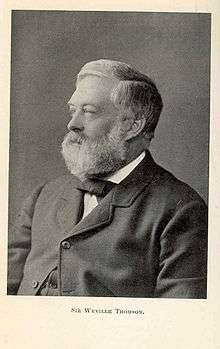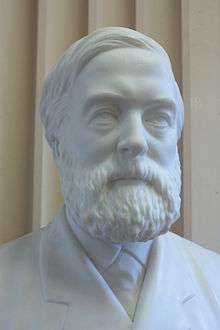Charles Wyville Thomson
Sir Charles Wyville Thomson FRSE FRS FLS FGS FZS (5 March 1830 – 10 March 1882) was a Scottish natural historian and marine zoologist. He served as the chief scientist on the Challenger expedition; his work there revolutionised oceanography and led to his knighthood.
Sir Charles Wyville Thomson FRSE FRS FLS FGS FZS | |
|---|---|
 Thomson in 1923 | |
| Born | 5 March 1830 |
| Died | 10 March 1882 (aged 52) Linlithgow |
| Nationality | Scottish |
| Alma mater | Merchiston Castle School[1] University of Edinburgh[1] |
| Known for | Challenger expedition |
| Awards | Royal Medal (1876) |
| Scientific career | |
| Fields | Marine zoology |
| Institutions | University of Aberdeen[1] (1850–1851) Marischal College[1] (1851–52) Queen's College, Cork Queen's University of Belfast |

Life
Thomson was born at Bonsyde, in Linlithgow, West Lothian, on 5 March 1830, the son of Andrew Thomson, a surgeon in the service of the East India Company, and his wife Sarah Ann Drummond Smith. He was baptised Wyville Thomas Charles Thomson, and changed his name in 1876.[2]
He was educated under Charles Chalmers at Merchiston Castle School, then from 1845 studied medicine at the University of Edinburgh graduating with an MD. However, his focus turned from medicine to natural science, and he joined the Botanical Society of Edinburgh in 1847, and soon after became secretary to the Royal Physical Society of Edinburgh. In 1850 he was attending the botany class of John Hutton Balfour at the University.
In 1850 he was appointed lecturer of botany, and in 1851 professor of botany, at the University of Aberdeen. In 1853 he became a professor of natural history in Queen's College, Cork, Ireland, succeeding Professor Hincks. A year later he was nominated to the chair of mineralogy and geology at the Queen's University of Belfast.
In 1855 he was elected a Fellow of the Royal Society of Edinburgh, his proposer being his former tutor, John Hutton Balfour. He served as the Society's Vice President from 1877 to 1882. He was elected a Fellow of the Royal Society of London in 1869.[3]
In 1860 was transferred to the chair of natural history at the same institution. In 1868 he assumed the duties of professor of botany at the Royal College of Science, Dublin, and finally in 1870 he received the natural history chair at the University of Edinburgh.
In 1871–72 he served as President of the Botanical Society of Edinburgh.[4]
Interests
Wyville Thomson is remembered for his studies of the biological conditions of the deep seas. Being interested in crinoids, and prompted by the results of the dredgings of Michael Sars in the deep sea off the Norwegian coasts, he persuaded the Royal Navy to grant him use of HMS Lightning and HMS Porcupine for deep sea dredging expeditions in the summers of 1868 and 1869. They showed that animal life existed down to depths of 650 fathoms (1200 m), that all marine invertebrate groups are present at this depth, and that deep-sea temperatures are not as constant as had been supposed, but vary considerably, and indicate oceanic circulation. These results were described in The Depths of the Sea, which he published in 1873.
Challenger expedition
The remarkable hydrographic and zoological results which Wyville Thomson had demonstrated, in addition to the growing demands of ocean telegraphy, soon led to the Royal Navy to grant use of HMS Challenger for a global expedition. Wyville Thomson was selected as chief scientist, and the ship sailed on 23 December 1872.
Aftermath
The Challenger Expedition was deemed a great success, and on his return Wyville Thomson received a number of academic honours, as well as a knighthood. In 1873 he published "Depths of the Sea" based on initial findings from the expedition.[5] In 1880 he published two volumes (having completed writing in 1877), The Voyage of the Challenger in the Atlantic, a preliminary account of the results of the voyage. He spent the next two years working on administrative duties connected with the publication of the full monograph of the voyage. Wyville Thomson had a highly strung mentality, and his health was generally poor throughout his life. He found dealing with publishers over the requirements of publishing 50 volumes of detailed illustration and scientific description enormously stressful. In 1879 he ceased to perform his university duties, gave up overseeing the reports of the expedition in 1881, took to his bed and died a broken man at Bonsyde on 10 March 1882. The publishing was finally completed by his friend and colleague Sir John Murray. Wyville Thomson is commemorated in the stained glass window above the altar in St. Michael's Parish Church, Linlithgow and his headstone is in the churchyard. In addition the Wyville-Thomson Ridge in the North Atlantic Ocean is named after him.
Evolution
Thomson had criticised natural selection, stating it was not enough to explain the evolution of species. Replying in the Nature journal, Charles Darwin commented that "I am sorry to find that Sir Wyville Thomson does not under stand the principle of natural selection, as explained by Mr. Wallace and myself... Can Sir Wyville Thomson name any one who has said that the evolution of species depends only on natural selection?"[6]
Publications
- The Depths of the Sea (1873)
- The Voyage of the Challenger (1877)
Family
In 1853 he married Jane Ramage Dawson. They were parents to Frank Wyville Thomson FRSE (1860-1918).
References
- "Sir C. Wyville Thomson". Encyclopædia Britannica. Retrieved 6 September 2015.
- Waterston, Charles D; Macmillan Shearer, A (July 2006). Former Fellows of the Royal Society of Edinburgh 1783-2002: Biographical Index (PDF). II. Edinburgh: The Royal Society of Edinburgh. ISBN 978-0-902198-84-5. Retrieved 3 January 2012.
- Biographical Index of Former Fellows of the Royal Society of Edinburgh 1783–2002 (PDF). The Royal Society of Edinburgh. July 2006. ISBN 0-902-198-84-X. Archived from the original (PDF) on 4 March 2016. Retrieved 4 December 2018.
- THE BOTANICAL SOCIETY OF EDINBURGH 1836-1936 (PDF). p. 15. Archived from the original (PDF) on 11 March 2017. Retrieved 11 August 2018.
- Harmsworth Encyclopedia 1905
- Darwin, Charles. (1880). Sir Wyville Thomson and Natural Selection. Nature 23: 32.

External links
| Wikimedia Commons has media related to Charles Wyville Thomson. |
- Works by or about Charles Wyville Thomson at Internet Archive
- . Dictionary of National Biography. London: Smith, Elder & Co. 1885–1900.
- Charles Wyville Thomson (1873). The Depths of the Sea: an account of the general results of the dredging cruises of H.M.SS. 'Porcupine' and 'Lightning' during the summers of 1868, 1869, and 1870, under the scientific direction of Dr. Carpenter, F.R.S., J. Gwyn Jeffreys, F.R.S., and Dr. Wyville Thomson, F.R.S. Internet Archive.